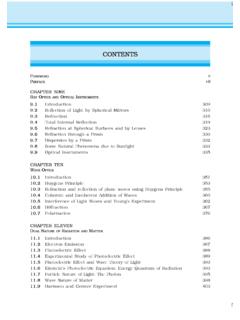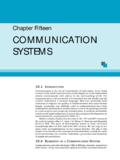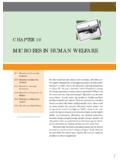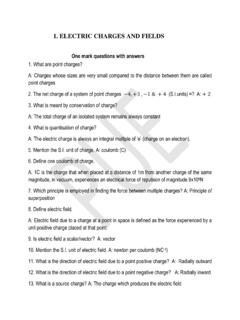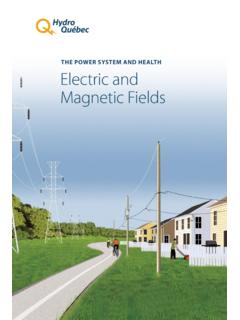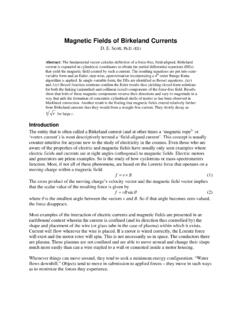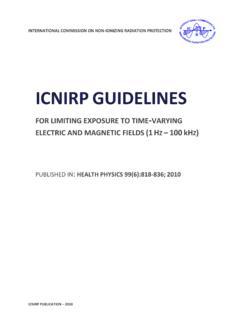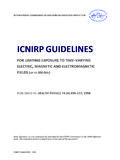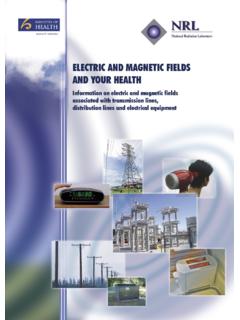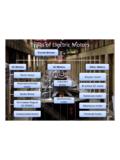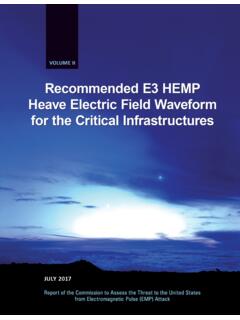Transcription of Chapter One ELECTRIC CHARGES AND FIELDS
1 INTRODUCTIONAll of us have the experience of seeing a spark or hearing a crackle whenwe take off our synthetic clothes or sweater, particularly in dry is almost inevitable with ladies garments like a polyester saree. Haveyou ever tried to find any explanation for this phenomenon? Anothercommon example of ELECTRIC discharge is the lightning that we see in thesky during thunderstorms. We also experience a sensation of an electricshock either while opening the door of a car or holding the iron bar of abus after sliding from our seat. The reason for these experiences isdischarge of ELECTRIC CHARGES through our body, which were accumulateddue to rubbing of insulating surfaces.
2 You might have also heard thatthis is due to generation of static electricity. This is precisely the topic weare going to discuss in this and the next Chapter . Static means anythingthat does not move or change with time. Electrostatics deals with thestudy of forces, FIELDS and potentials arising from static ELECTRIC CHARGEH istorically the credit of discovery of the fact that amber rubbed withwool or silk cloth attracts light objects goes to Thales of Miletus, Greece,around 600 BC. The name electricity is coined from the Greek wordelektron meaning amber. Many such pairs of materials were known whichChapter OneELECTRIC CHARGESAND FIELDS2 Physicson rubbing could attract light objectslike straw, pith balls and bits of can perform the following activityat home to experience such an out long thin strips of white paperand lightly iron them.
3 Take them near aTV screen or computer monitor. You willsee that the strips get attracted to thescreen. In fact they remain stuck to thescreen for a was observed that if two glass rodsrubbed with wool or silk cloth arebrought close to each other, they repeleach other [Fig. (a)]. The two strandsof wool or two pieces of silk cloth, withwhich the rods were rubbed, also repeleach other. However, the glass rod andwool attracted each other. Similarly, two plastic rods rubbed with cat sfur repelled each other [Fig. (b)] but attracted the fur. On the otherhand, the plastic rod attracts the glass rod [Fig.]
4 (c)] and repel the silkor wool with which the glass rod is rubbed. The glass rod repels the a plastic rod rubbed with fur is made to touch two small pith balls(now-a-days we can use polystyrene balls) suspended by silk or nylonthread, then the balls repel each other [Fig. (d)] and are also repelledby the rod. A similar effect is found if the pith balls are touched with aglass rod rubbed with silk [Fig. (e)]. A dramatic observation is that apith ball touched with glass rod attracts another pith ball touched withplastic rod [Fig. (f )].These seemingly simple facts were established from years of effortsand careful experiments and their analyses.
5 It was concluded, after manycareful studies by different scientists, that there were only two kinds ofan entity which is called the ELECTRIC charge. We say that the bodies likeglass or plastic rods, silk, fur and pith balls are electrified. They acquirean ELECTRIC charge on rubbing. The experiments on pith balls suggestedthat there are two kinds of electrification and we find that (i) like chargesrepel and (ii) unlike CHARGES attract each other. The experiments alsodemonstrated that the CHARGES are transferred from the rods to the pithballs on contact. It is said that the pith balls are electrified or are chargedby contact.
6 The property which differentiates the two kinds of CHARGES iscalled the polarity of a glass rod is rubbed with silk, the rod acquires one kind ofcharge and the silk acquires the second kind of charge. This is true forany pair of objects that are rubbed to be electrified. Now if the electrifiedglass rod is brought in contact with silk, with which it was rubbed, theyno longer attract each other. They also do not attract or repel other lightobjects as they did on being , the CHARGES acquired after rubbing are lost when the chargedbodies are brought in contact. What can you conclude from theseobservations?
7 It just tells us that unlike CHARGES acquired by the objectsFIGURE Rods and pith balls: like CHARGES repel andunlike CHARGES attract each animation on simple electrostatic experiments: Chargesand Fields3neutralise or nullify each other s effect. Therefore the CHARGES were namedas positive and negative by the American scientist Benjamin know that when we add a positive number to a negative number ofthe same magnitude, the sum is zero. This might have been thephilosophy in naming the CHARGES as positive and negative. By convention,the charge on glass rod or cat s fur is called positive and that on plasticrod or silk is termed negative.
8 If an object possesses an ELECTRIC charge, itis said to be electrified or charged. When it has no charge it is said to OF ELECTRICITY AND MAGNETISMIn olden days, electricity and magnetism were treated as separate subjects. Electricitydealt with CHARGES on glass rods, cat s fur, batteries, lightning, etc., while magnetismdescribed interactions of magnets, iron filings, compass needles, etc. In 1820 Danishscientist Oersted found that a compass needle is deflected by passing an ELECTRIC currentthrough a wire placed near the needle. Ampere and Faraday supported this observationby saying that ELECTRIC CHARGES in motion produce magnetic FIELDS and moving magnetsgenerate electricity.
9 The unification was achieved when the Scottish physicist Maxwelland the Dutch physicist Lorentz put forward a theory where they showed theinterdependence of these two subjects. This field is called electromagnetism. Most of thephenomena occurring around us can be described under electromagnetism. Virtuallyevery force that we can think of like friction, chemical force between atoms holding thematter together, and even the forces describing processes occurring in cells of livingorganisms, have its origin in electromagnetic force. Electromagnetic force is one of thefundamental forces of put forth four equations that play the same role in classical electromagnetismas Newton s equations of motion and gravitation law play in mechanics.
10 He also arguedthat light is electromagnetic in nature and its speed can be found by making purelyelectric and magnetic measurements. He claimed that the science of optics is intimatelyrelated to that of electricity and science of electricity and magnetism is the foundation for the modern technologicalcivilisation. ELECTRIC power, telecommunication, radio and television, and a wide varietyof the practical appliances used in daily life are based on the principles of this charged particles in motion exert both ELECTRIC and magnetic forces, in theframe of reference where all the CHARGES are at rest, the forces are purely electrical.


